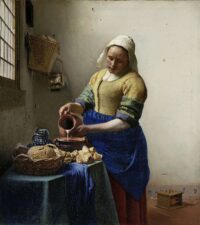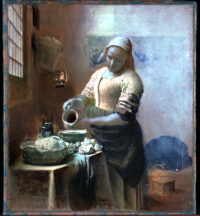 A new study of Johannes Vermeer’s masterpiece The Milkmaid has revealed painted-over details of his original composition that shed new light on his artistic process.
A new study of Johannes Vermeer’s masterpiece The Milkmaid has revealed painted-over details of his original composition that shed new light on his artistic process.
Next year, the Rijksmuseum is bringing together 27 of the 35 known paintings by Vermeer in a landmark exhibition dedicated to the 17th century Delft master. There will be works on loan from the Frick Collection in New York, the Mauritshuis in The Hague, the Städel Museum in Frankfurt am Main, the National Gallery of Ireland in Dublin and the National Gallery of Art in Washington DC.
In the run-up to the new exhibition that opens in February of 2023, the Rijksmuseum has been working with the Mauritshuis and the University of Antwerp to study all of the works by Vermeer that are currently in the Netherlands using state-of-the-art analytical technology. The four Vermeers in the Rijksmuseum’s permanent collection — The Milkmaid, The Little Street, The Love Letter and Woman Reading a Letter — have been photographed in ultra-high resolution, scanned with Optical Coherence Tomography, Macro-XRF and Short Wavelength Infrared Reflectance (SWIR), an imaging technology used for industrial inspections and military applications.
 It was the SWIR imaging that brought to light two objects Vermeer had painted over before completing them on The Milkmaid: a jug holder with jugs hanging from the handles behind the milkmaid’s head, and a fire basket at her feet. The presence of something in those areas had been noted in previous X-rays, but the older technology could not make out what they were. Experts thought it might be a fireplace behind her hand. The detail is so much greater that conservators were able to identify the jug holder and the fire basket from the incomplete underpainting. Vermeer’s estate inventory records that he had a jug holder in his pantry and a fire basket (used to hold glowing coals to warm a baby’s bedding, clothing and the baby itself).
It was the SWIR imaging that brought to light two objects Vermeer had painted over before completing them on The Milkmaid: a jug holder with jugs hanging from the handles behind the milkmaid’s head, and a fire basket at her feet. The presence of something in those areas had been noted in previous X-rays, but the older technology could not make out what they were. Experts thought it might be a fireplace behind her hand. The detail is so much greater that conservators were able to identify the jug holder and the fire basket from the incomplete underpainting. Vermeer’s estate inventory records that he had a jug holder in his pantry and a fire basket (used to hold glowing coals to warm a baby’s bedding, clothing and the baby itself).
This discovery sheds entirely new light on Vermeer’s methods. The general assumption was that the artist produced his small oeuvre very slowly, and always worked with extreme precision. This view is now being revised. A hastily applied thick line of black paint can be seen beneath the milkmaid’s left arm. This sketch shows clearly that Vermeer first quickly painted the scene in light and dark tones before developing the detail.
A similar preliminary sketch in black paint can be seen on the wall behind the young woman’s head. By comparing the results produced using the latest research techniques, it has now become clear that Vermeer used black paint to sketch a jug holder and several jugs, but didn’t develop them any further. The jug holder, a plank of wood with nobs attached, was used in 17th-century kitchens for hanging up multiple ceramic jugs by the handle. A pantry in Vermeer’s own home contained a similar item, and a miniature version of just such a jug holder can be found elsewhere in the Rijksmuseum, in Petronella Oortman’s dolls’ house (c. 1690).
The new discoveries are explained with great visuals in this video which is the third in a series the Rijksmuseum has produced about its research into Vermeer’s masterworks. See the second video in the series, which follows conservators as they image the four works in the museum’s permanent collection, here. The first video in the series focuses on The Milkmaid and The Little Street.